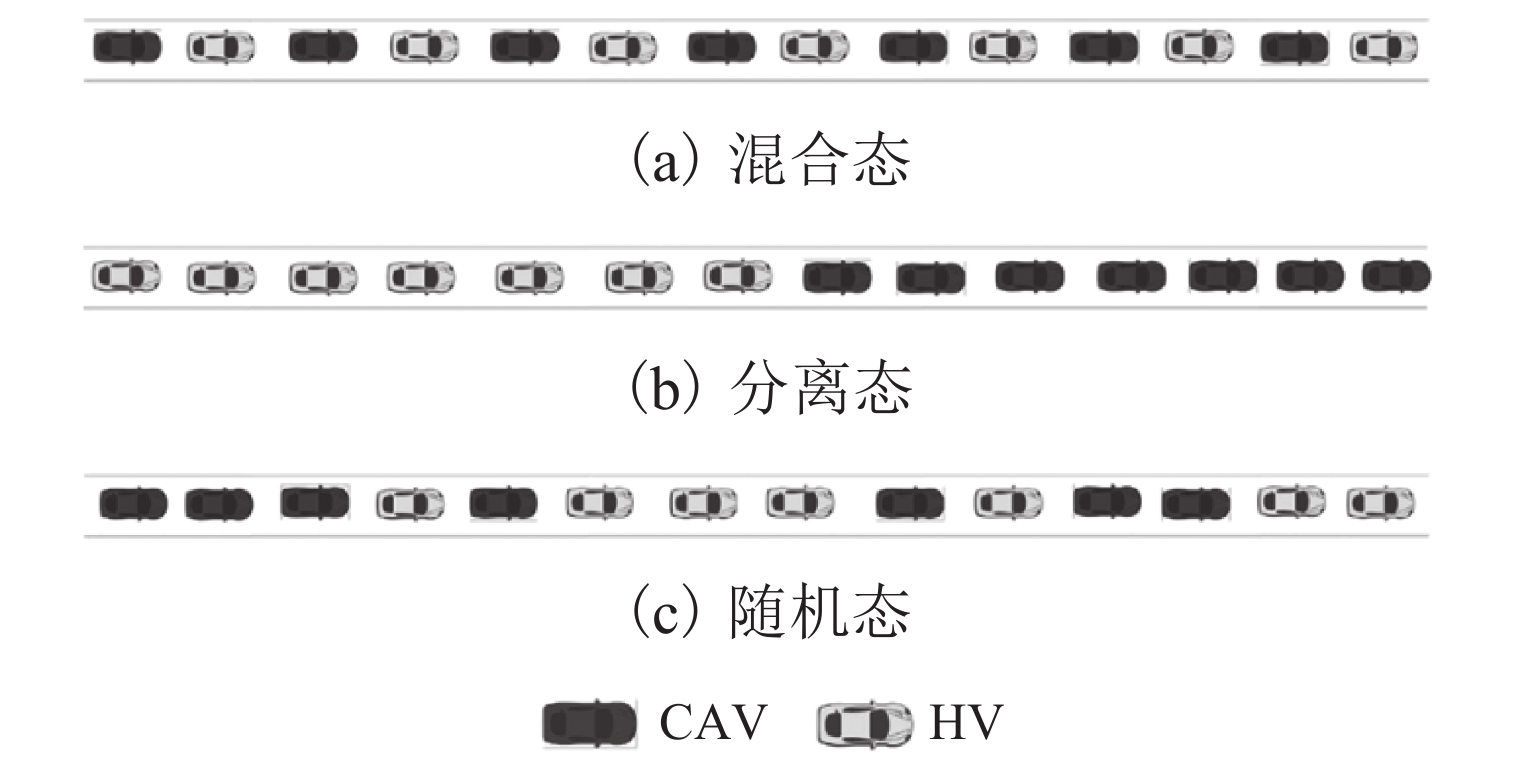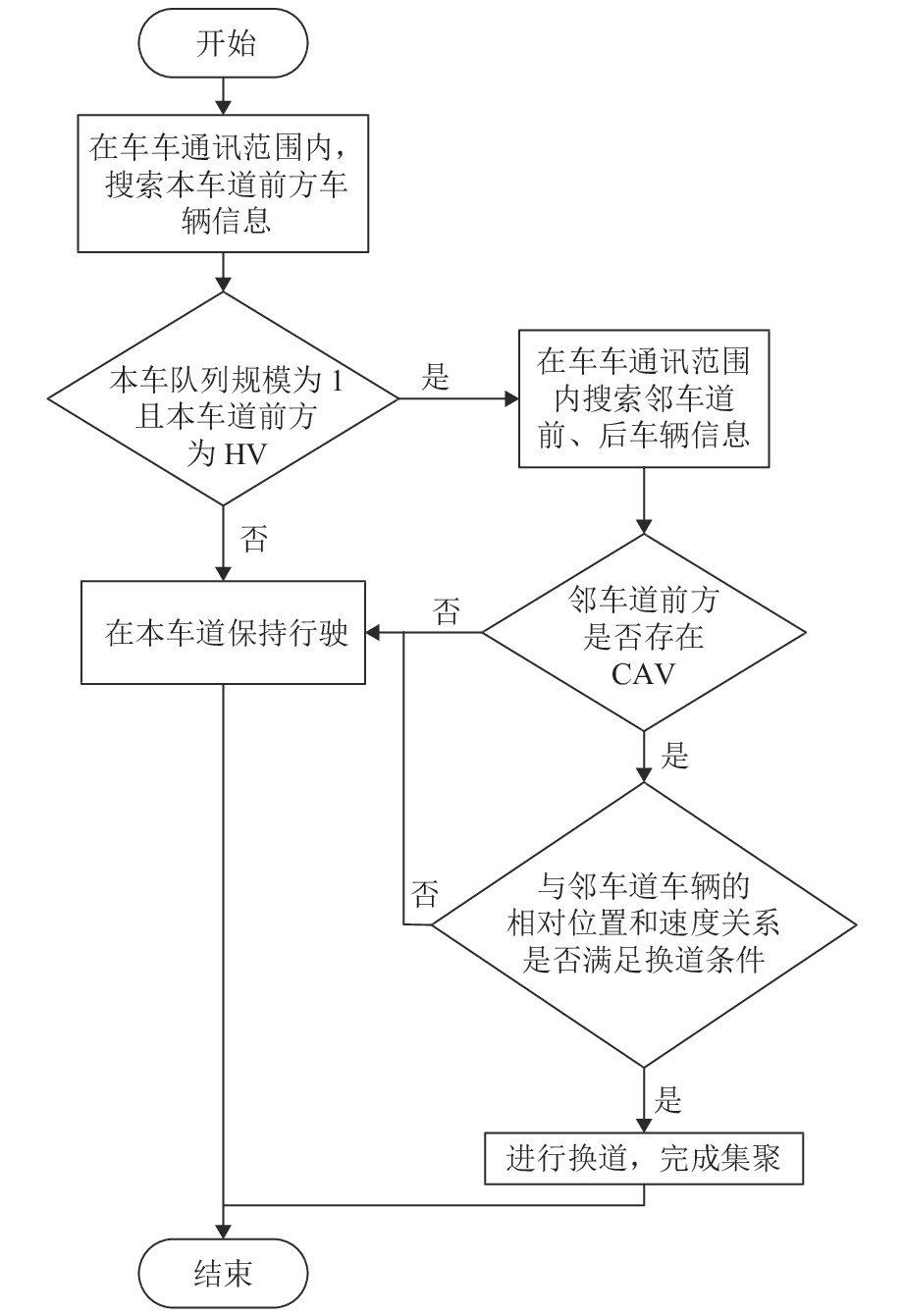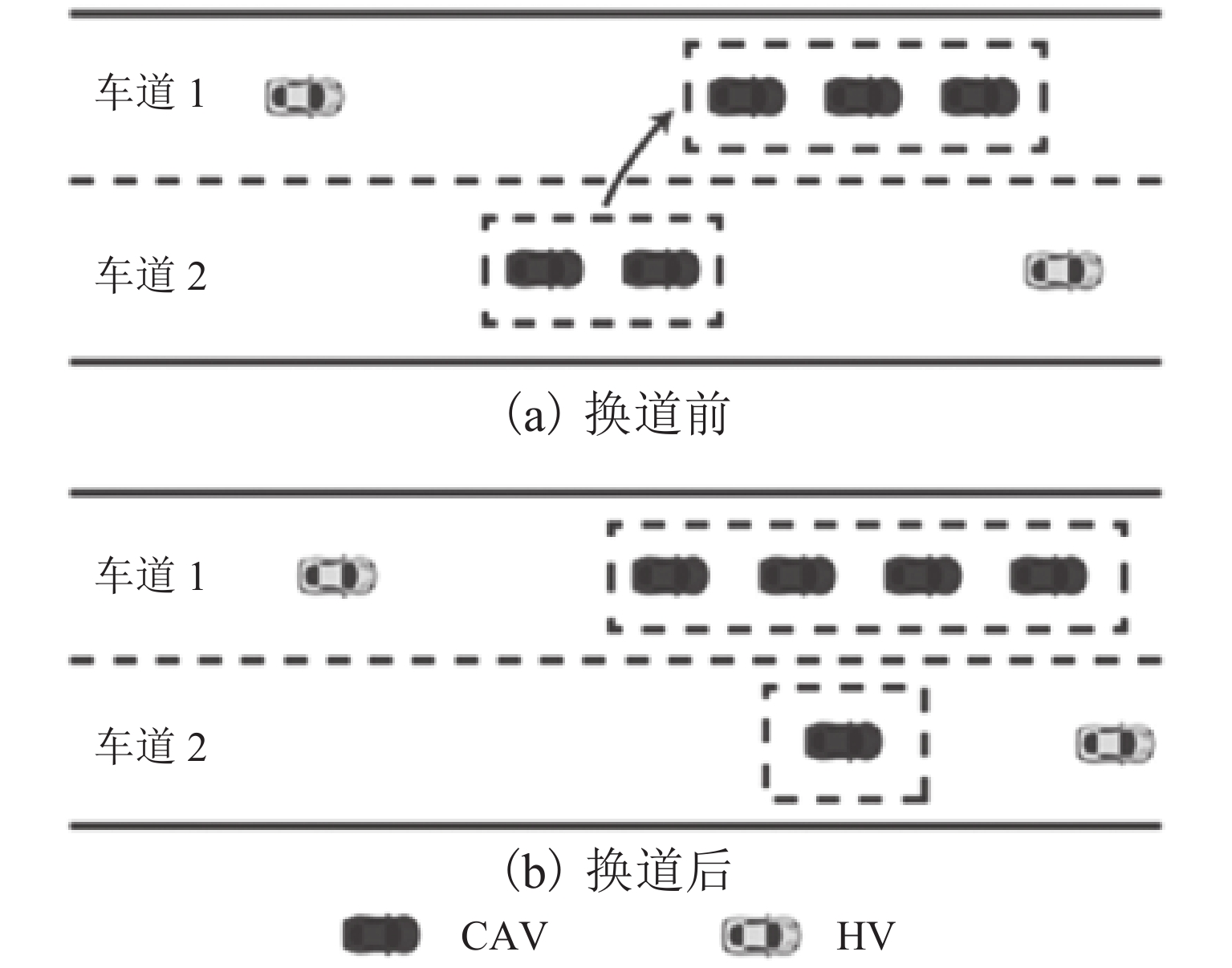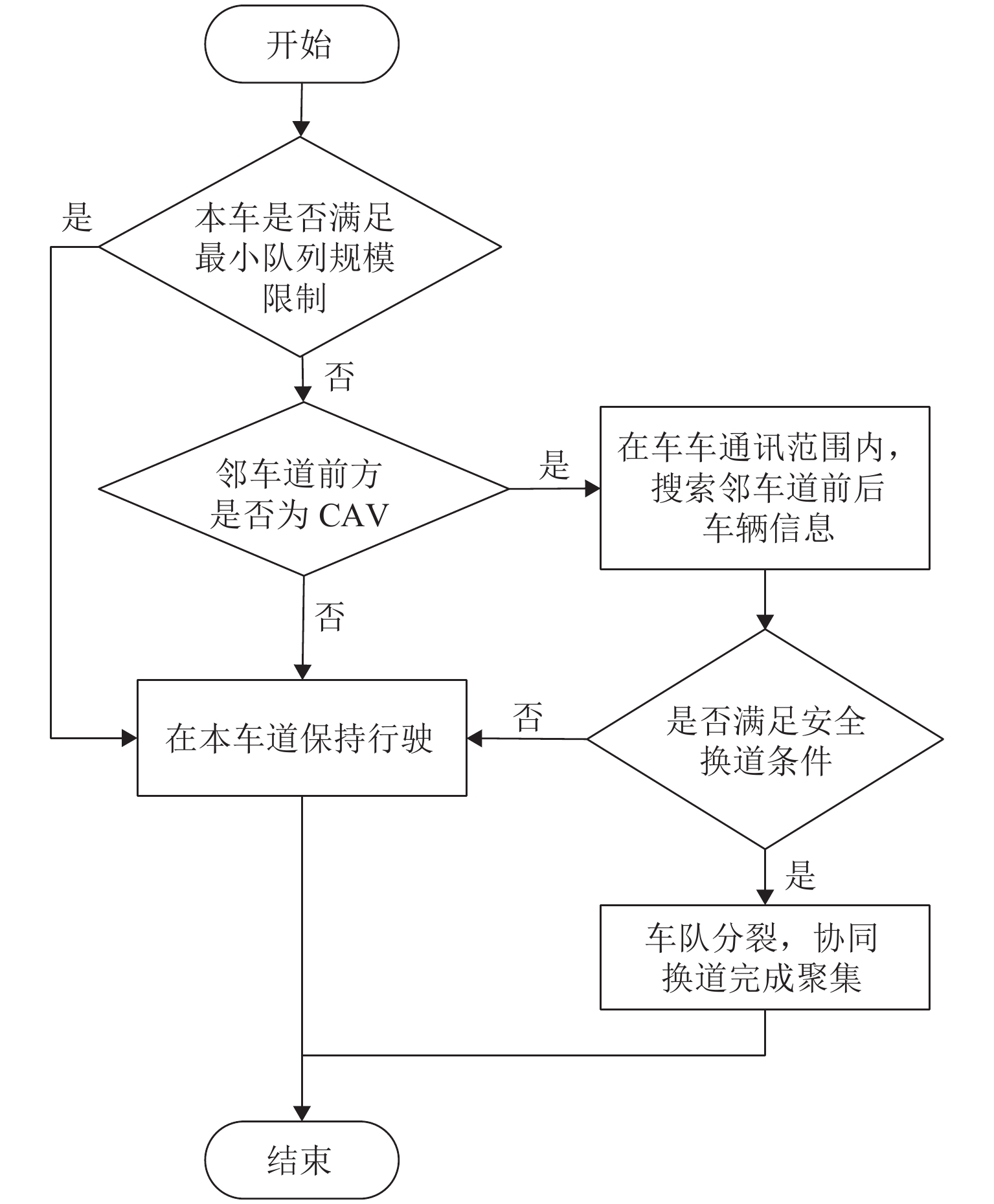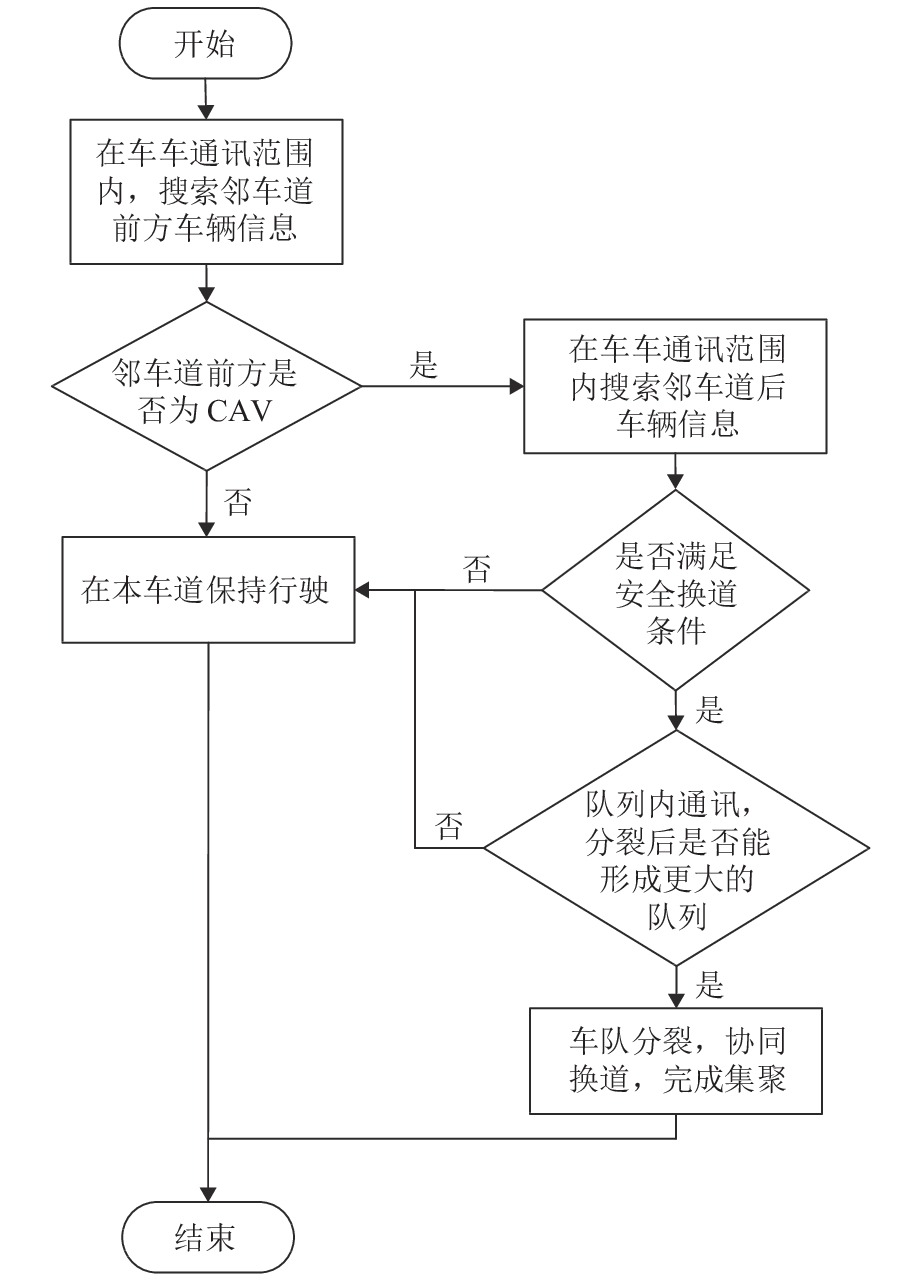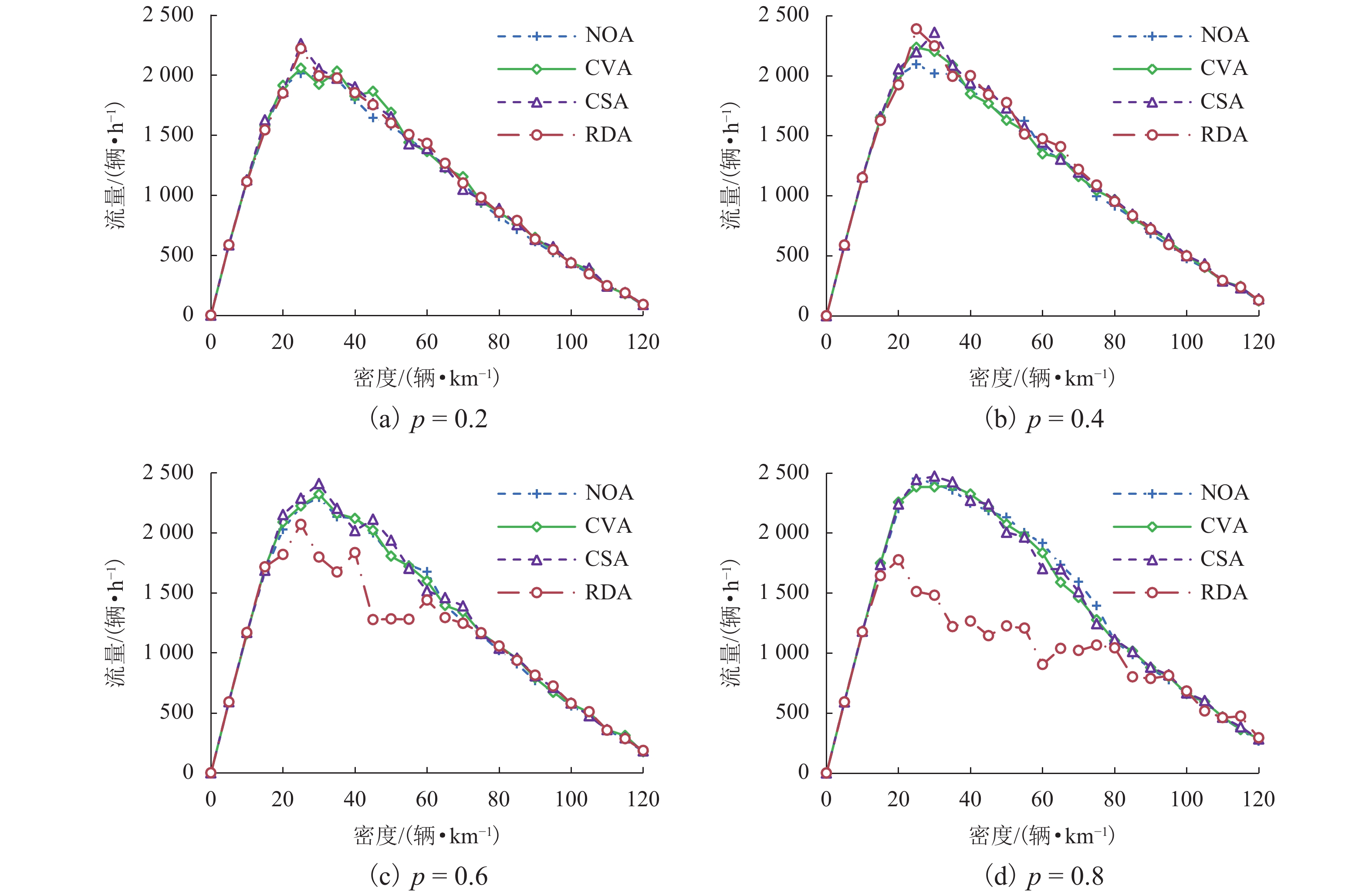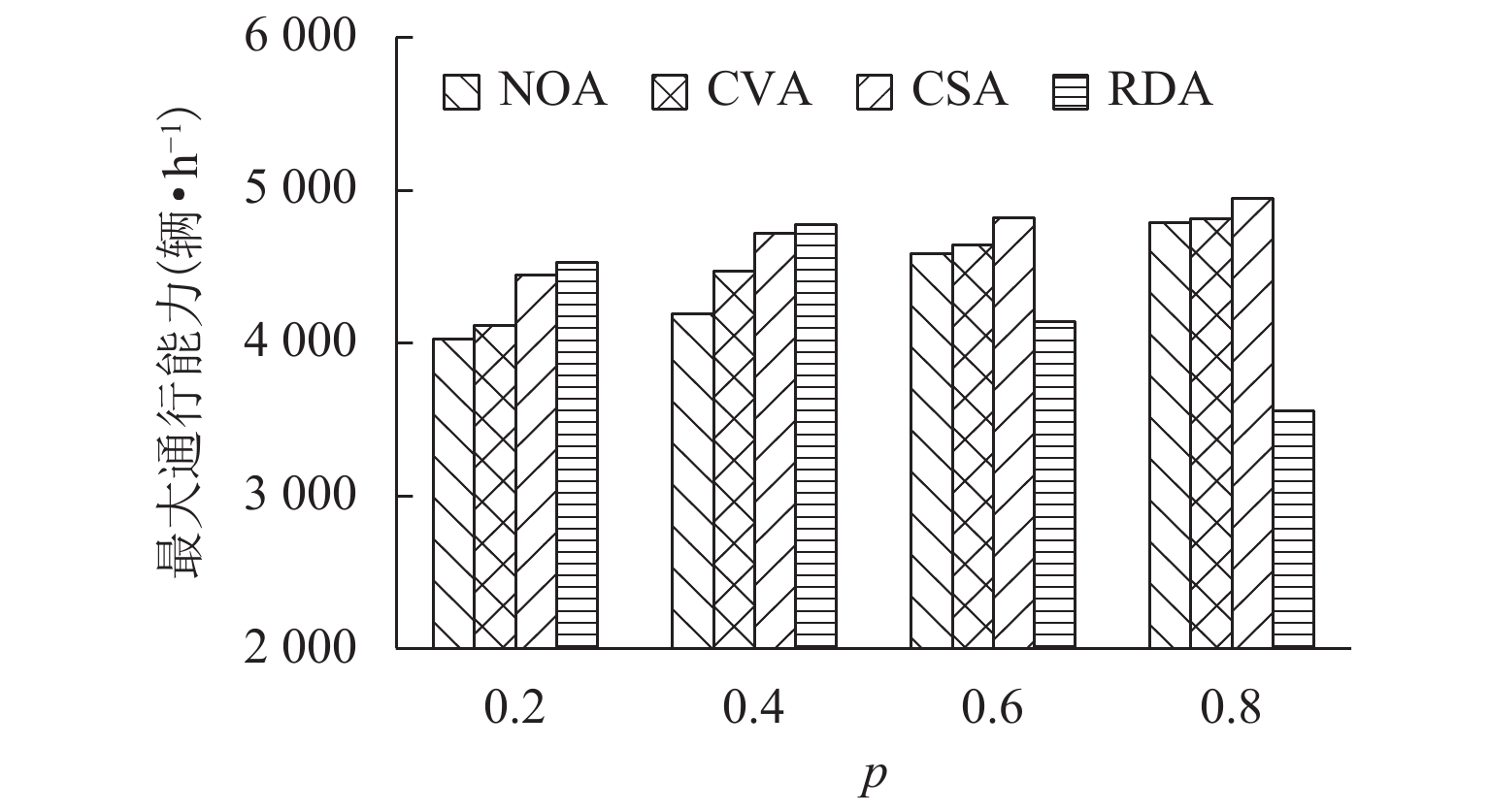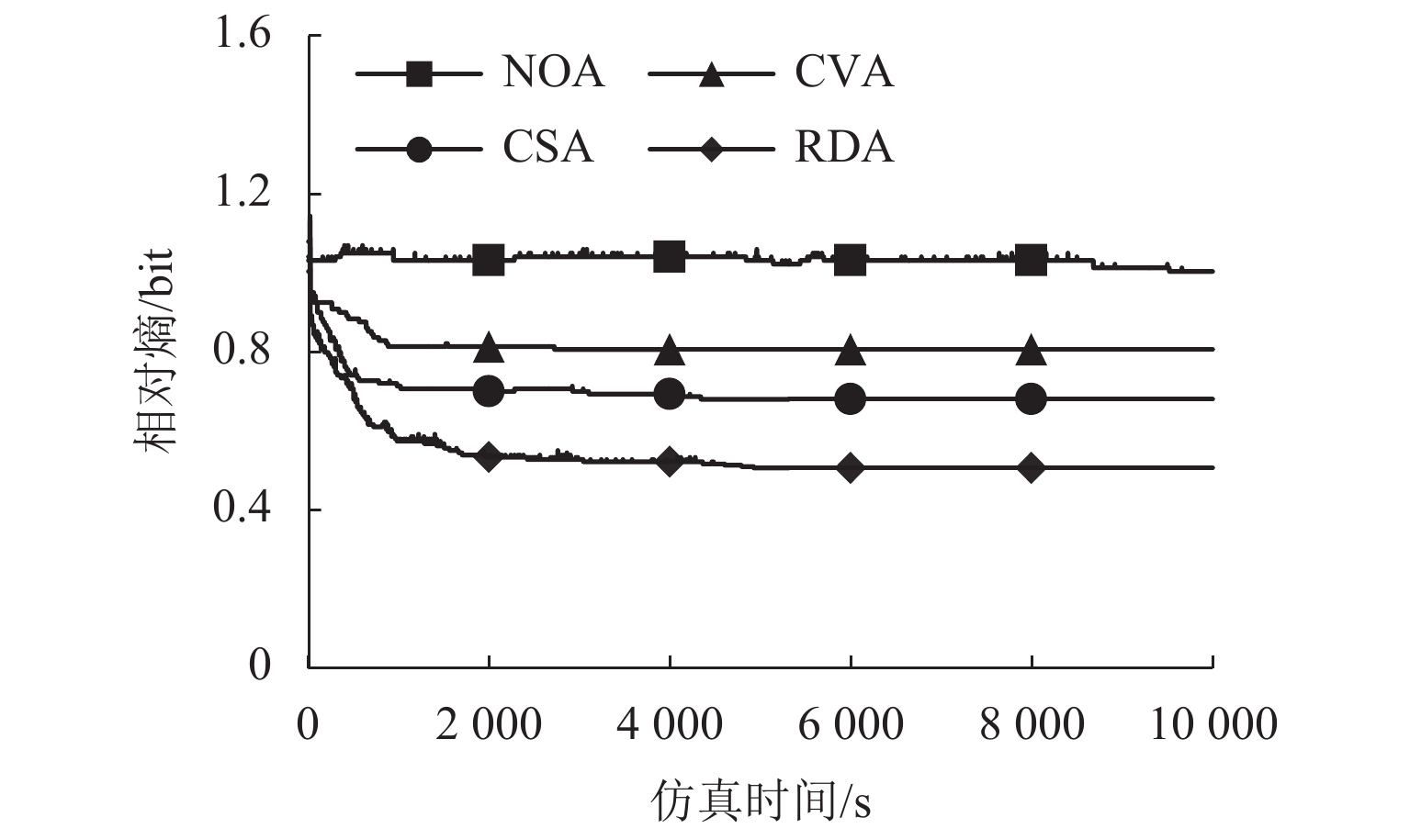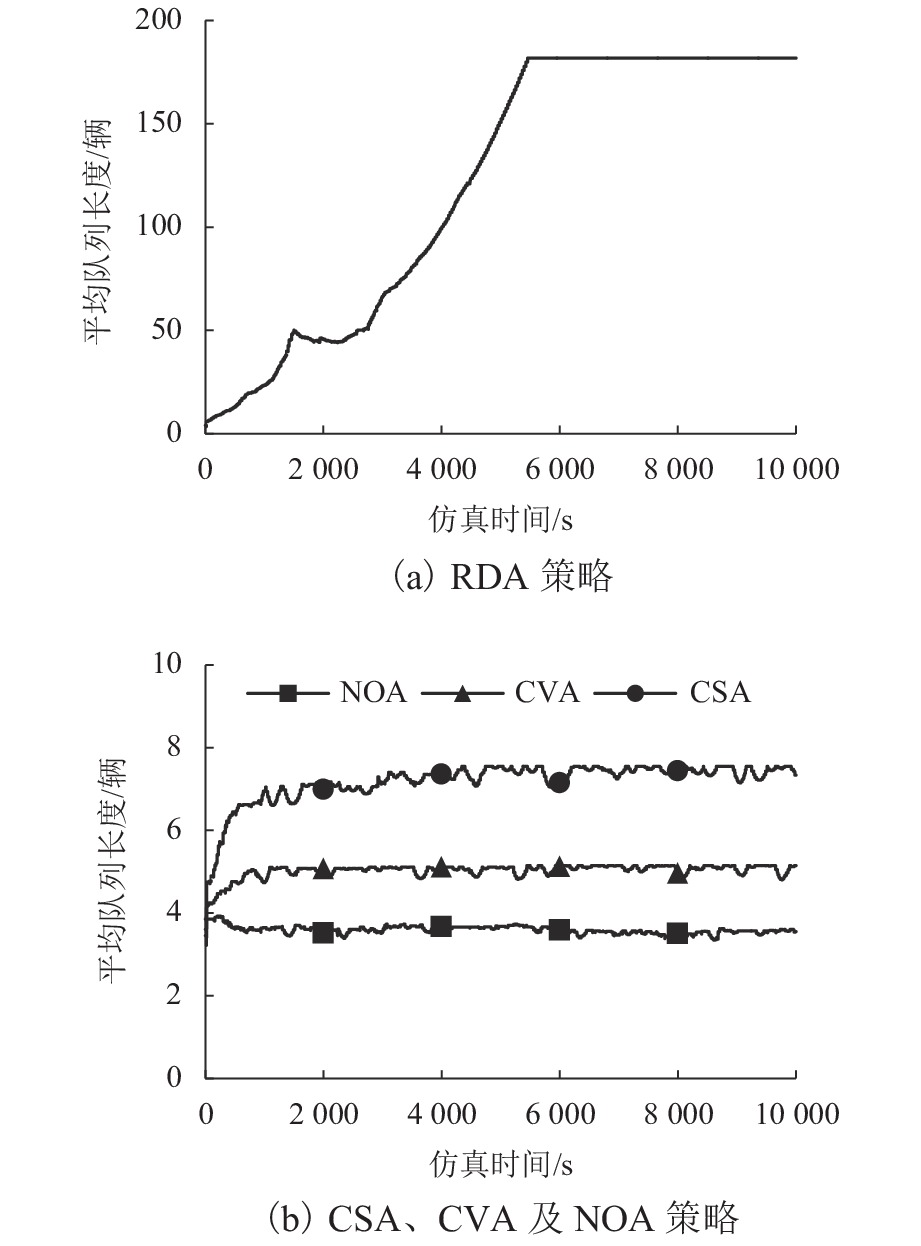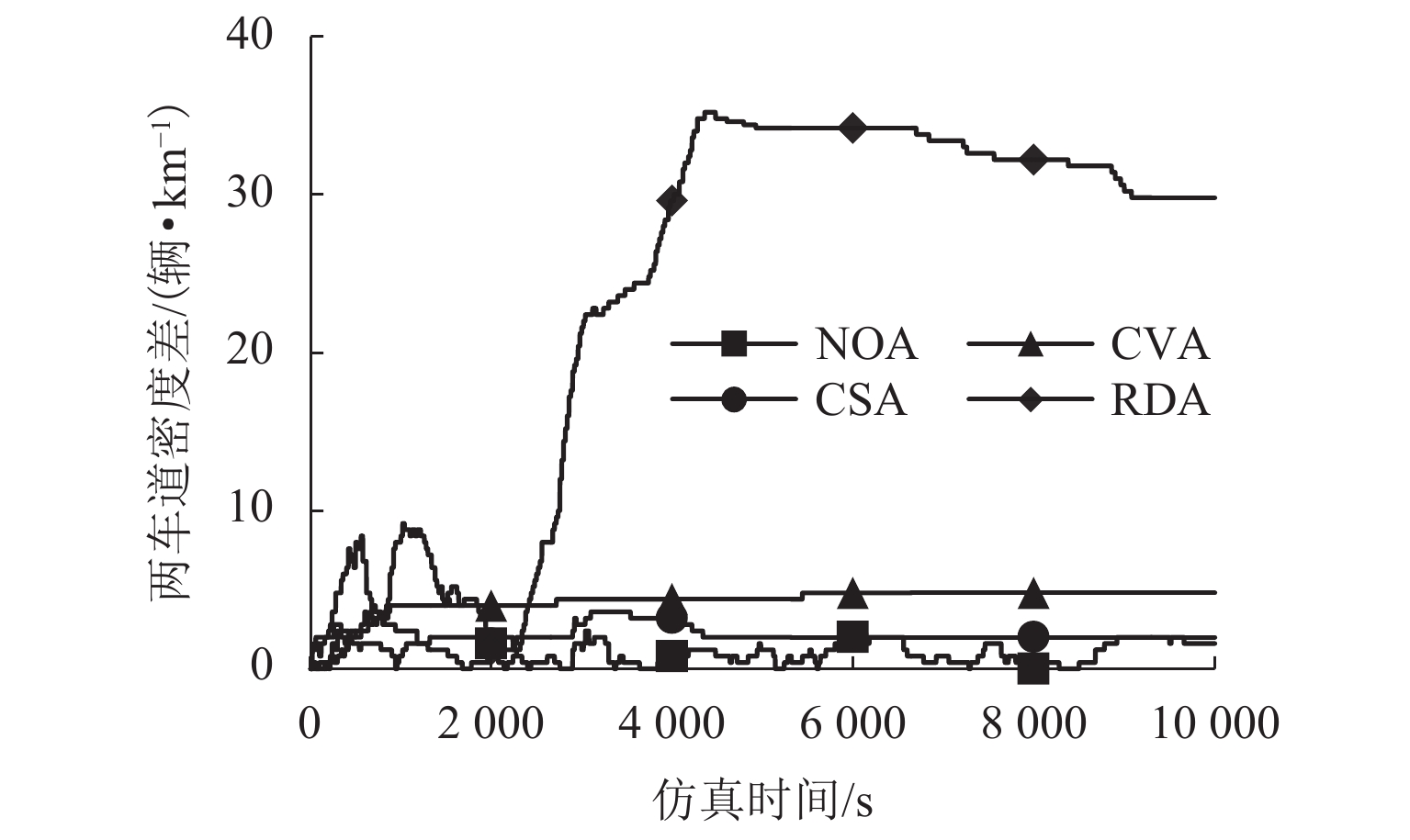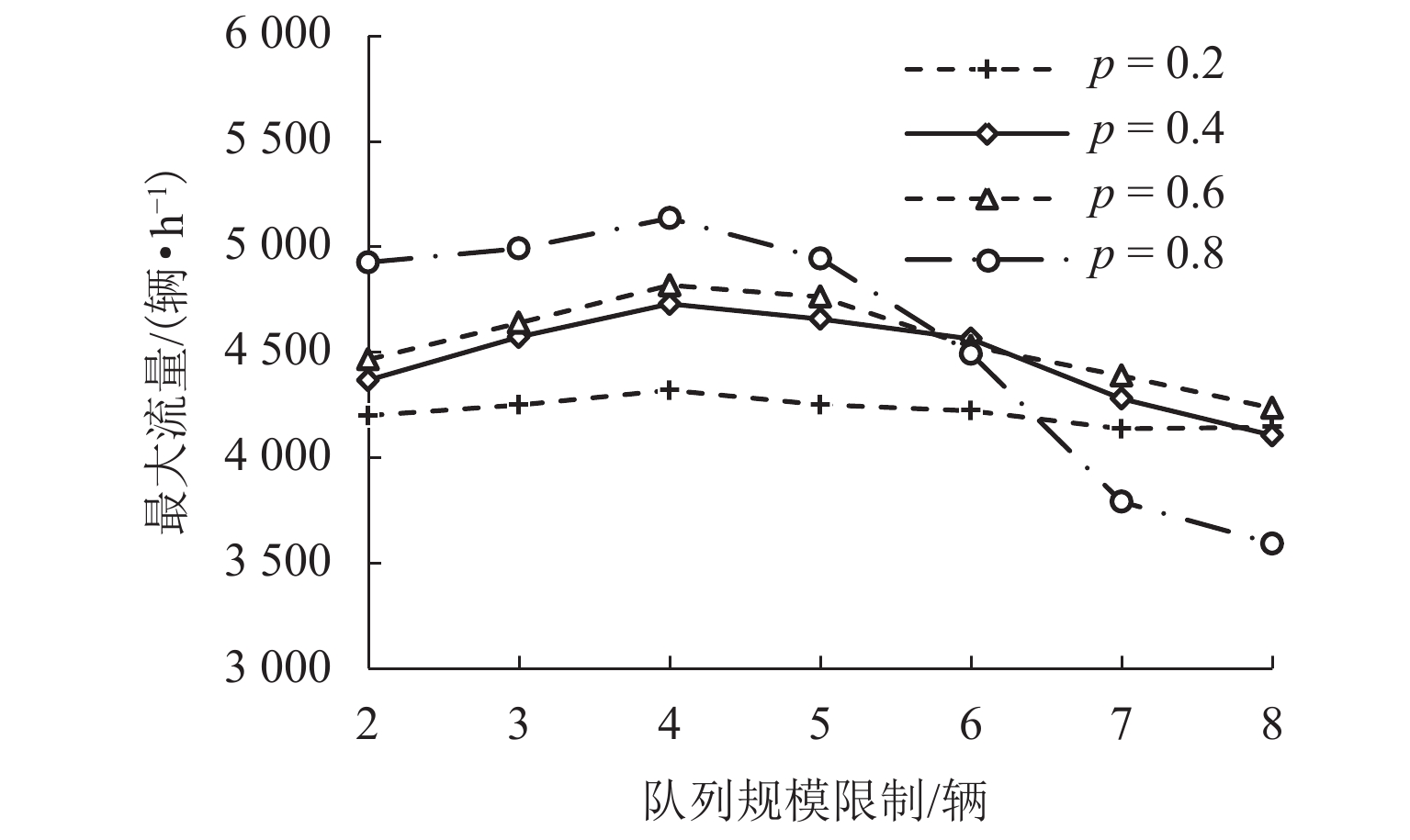Hybrid Characteristics of Heterogeneous Traffic Flow Under Different Aggregating Lane-Change Strategies in Intelligent Network
-
摘要:
为研究车联网环境下异质交通流的演变规律,首先,引入相对熵定量描述异质流的有序性,并分析有序性与智能网联车(connected and autonomous vehicle,CAV)市场渗透率、协同自适应巡航控制(cooperative adaptive cruise control,CACC)队列数之间的内在联系,推导得出智能网联车渗透率的增加及队列数的减少可以提升异质流的有序性;其次,提出了保守型集聚(conservative aggregation,CSA)、激进型集聚(radical aggregation,RDA)两种改进的智能网联车集聚换道策略,并通过元胞自动机仿真实验,从通行能力、相对熵和平均队列长度等方面比较了无集聚(no aggregation,NOA)、常规集聚(conventional aggregation,CVA)、CSA、RDA 4种换道策略的优劣;最后,在CSA换道策略中分析了不同最小队列规模限制对于通行能力的影响. 研究结果表明:在双车道环境下,采取集聚换道策略能使智能网联车形成CACC队列,使异质流趋于“有序”,在20~95辆/km密度范围内提升通行能力;相比NOA换道策略,CSA、RDA换道策略分别最大提升道路通行能力12.6%、14.0%,但当智能网联车市场渗透率为0.8时,RDA换道策略导致最大通行能力反而降低25.8%;根据相对熵对异质流中智能网联车辆集聚程度的定量描述,NOA、CVA、CSA、RDA 4种换道策略对智能网联的集聚能力依次递增;在CSA换道策略中,CACC最小队列规模取4辆时道路通行效率达到最佳.
Abstract:In order to study the evolution rule of heterogeneous traffic flow under the background of IOV (internet of vehicles), the concept of relative entropy in introduced to quantitatively describe the orderliness of heterogeneous flow, and analyze the inner link among orderliness, market penetration rate of CAV (connected and autonomous vehicle)and the number of queues for CACC (cooperative adaptive cruise control). Then, it is deduced that the increase on the market penetration rate of CAV and decrease on the number of queues can improve the orderliness of heterogeneous flow. Second, two improved lane change strategies for CAVs are proposed, namely, conservative aggregation (CSA) and radical aggregation (RDA). Through the simulation test of cellular automata, the advantages and disadvantages of no aggregation (NOA), conventional aggregation (CVA), CSA, and RDA are compared in terms of traffic capacity, relative entropy and average queue length. Finally, the effect of different limits of minimum queue size on traffic capacity is analyzed with the lane change strategy of CSA. The results show that the use of lane change strategy can prompt the CACC collaborative queue in CAV and orderly heterogeneous flow. It improves traffic capacity in the density range from 20 to 95 veh/km. Compared with the NOA strategy, the CSA strategy increases the traffic capacity by 12.6%, and the RDA strategy by 14.0%. However, when the market penetration rate of CAV is 0.8, the maximum traffic capacity of the RDA strategy is reduced by 25.8%. According to the quantitative description of relative entropy for the aggregation degree of CAV in heterogeneous flow, four lane change strategies (NOA, CVA, CSA and RDA) increases the aggregation degree of CAV in turn. In the CSA strategy, when the minimum queue size of CACC takes 4 vehicles, the efficiency of traffic capacity is the optimal.
-
随着汽车产业与人工智能、物联网、云计算等新一代信息技术深度融合发展,智能网联车辆(connected and autonomous vehicle,CAV)应运而生. 自适应巡航控制(adaptive cruise control,ACC)是CAV采用的一种纵向跟驰控制技术,其应用车载检测设备获取前车加速度、速度等信息,实现本车的加速度优化. 协同自适应巡航控制(cooperative adaptive cruise control,CACC)立足于ACC,利用车车通信获取前车行驶信息. 相比ACC系统,CACC更加精确,但其功能的实现需要前车安装车车通信设备. 因此,当CACC车辆跟随人工驾驶车辆(human-driving vehicle,HV)行驶时,由于HV缺乏车车通信设备,CACC车辆将自动退化为ACC车辆,同时仍保留车车通信系统,与紧随其后的CACC车辆实现车车通信,并以协同队列状态行驶.
CAV的普及是一个长期的过程,未来道路交通流将长期处于ACC-CACC-HV混合阶段. 相比于HV的随机性,CAV具有良好的可控性,如若能设计出良好的CAV换道策略,使CAV得以集聚,形成CACC协同队列行驶,则能在CAV市场渗透率一定的情况下提升道路通行效率.
随着CAV渗透率的增加,道路通行能力将会有明显的提升[1]. CACC相比于ACC具有更小的跟车时距及更好的稳定性[2],在渗透率一定的情况下,CACC协同队列数量与长度的增加能有效提升道路通行效率[3-5]. Ye等[6]引入CAV专用车道,分析了不同密度及渗透率下交通流情况. Papadoulis等[7]利用VISSIM外部接口开发CAV控制算法,分析了CAV队列对道路交通安全性的影响. Zhong等[8]利用VISSIM开发车道管理策略,从多个角度探索了CAV对于交通流的影响. 梁军等[9]利用CAV混行集聚多目标智能体和元胞自动机模型提出了一种CAV换道集聚策略,仿真证明了所提集聚策略能使得较多CAV以协同队列行驶,能在一定条件下改善交通流环境,但其并未讨论CACC队列拆分再集聚情况,对CAV的集聚程度也缺乏进一步研究.
综上所述,对于CAV的协同队列研究国内外有了一定的结论与成果,但基于CAV换道集聚动机的研究较少,对于集聚换道策略的考虑尚有不足. 基于此,本文提出两种改善的CAV换道集聚策略,并利用吴德华等[10]提出的相对熵定量描述不同换道策略下CAV的集聚程度.
1. 异质交通流的有序性
1.1 CAV形成队列的讨论
设道路上HV的渗透率为
p1 ,CAV的渗透率为p2 ,则p1+p2=1 . CAV以CACC、ACC状态行驶的概率分别为pCA 、pAC ,则p2=pAC+pCA . 由文献[11]知:在随机分布下,出现CACC的概率为p22 ,出现ACC的概率为p1p2 .在CACC协同车队规模为S的条件下,车队中第i个位置的车辆类型
T(i) 为CAV的概率设为Pa(T(i)=CAV|S) ,同理知Pa(T(i)=HV|S) 的意义. 当S=0 时,Pa(T(i)=HV|0)=1 ,Pa(T(i)=CAV|0)=0 ;当S>1 ,并且车辆为车队中跟驰位置(i>1 )时,Pa(T(i)=CAV|S)=Pa(T(i−1)=CAV|S)p2,S=2,3,⋯, (1) 则CAV异质流中车队规模为S的概率为
Pa(T(i)=CAV|S)=Pa(T(i−1)=CAV|S)p2 = Pa(T(1)=CAV|S)pS−22=p1pS−12. (2) 设道路上有N辆车,包括N1辆HV、N2辆CAV,有m个CAV队列,
m∈[1,N2] ,队列数分别为S1,S2,⋯,Sm ,则有m∑i=1Si=N2,Si=0,2,3,4,⋯. (3) CACC状态的车辆数为
(S1−1)+(S2−1)+⋯ + (Sm−1) = (S1+S2+⋯Sm)−m=N2−m. (4) CACC状态车辆出现的频率为
N2−mN=Np2−mN. (5) 由式(5)知,减少队列数
m 和提高CAV市场渗透率p2 均可提高CAV中CACC状态车辆出现的概率,更好地形成CACC协同队列. 但由式(2)知,在CAV渗透率一定时,大规模CACC队列出现的概率随队列规模的增大而减小,即在随机分布下,CACC队列规模越大,其形成愈发困难.1.2 相对熵的应用
异质流会由于CAV与HV的排列方式而呈现不同特性. 如在相同渗透率(50%)下,HV与CAV在单车道上可能以混合态、分离态、随机态3种方式排列行驶,如图1所示. 以CACC状态行驶的CAV车辆数从高到低依次为分离态、随机态和混合态,则道路通行效率:分离态 > 随机态 > 混合态.
异质交通流中,HV与CAV的排列方式[12]可视为一个道路系统“内在的混乱程度”. 研究交通流有序问题的一个基本条件是如何判断交通流的有序与无序[13-14]. 本文对CAV异质流有序定义为相同密度下,道路上所有车辆以CACC状态行驶即有序.
文献[10]提出相对熵的概念用以描述CAV异质流的有序性. 相对熵可以定量计算两个概率分布的差异,未来可通过车联网技术检测异质流中车辆的行驶状态x (
x∈ {CACC,ACC,HV}),得到异质流的行驶状态分布Q(x) ,求得与有序分布P(x) 的差异,即可得到CAV异质流的有序性. 相对熵为DKL=∑P(x)log(P(x)Q(x)). (6) 异质交通有序流分布服从概率分布:
P(x)={1, x= CACC, 0, 其他. (7) 实际道路交通流车辆行驶状态服从概率分布:
Q(x)={Np2−mN,x=CACC,1−Np2−mN,其他. (8) 联合式(6)~(8)可得
DKL=−log(Np2−mN). (9) 由式(9)知:在队列数
m 一定时,随着CAV市场渗透率p2 的增加,异质流的相对熵减小,道路趋于有序,更多CAV以CACC队列状态行驶;在CAV市场渗透率p2 一定时,队列数m 的减小,异质流相对熵减小,道路趋于有序,更多CAV以CACC队列状态行驶. 即若需提高异质流的有序性,可以通过增加CAV渗透率p2 和减少队列数m 两方面入手.2. 基于集聚动机CAV换道策略
相比于HV的随机性,CAV具有良好的可控性,合理的CAV换道策略能使CAV集聚,以CACC协同队列行驶,增加异质流有序性,提升道路通行效率. 梁军等[9]及Zhou等[15]提出了一种换道集聚策略,本文称其为常规集聚(conventional aggregation, CVA)换道策略(如图2),仿真证明CVA集聚策略使得较多CAV以协同队列行驶,并在一定条件下改善交通流环境,但其并未量化CACC的集聚程度及考虑CACC的最小队列规模限制.
本文将单向双车道作为研究对象,以车辆向左换道为例,如图3所示.
车辆换道策略变量、纵向更新变量及跟驰变量说明如下:
X(L) 为本车位于车道L; L+1、L−1分别表示相邻车道相对目标车道位置的右侧、左侧;下同.xn(t) 为第n辆车在时刻t的位置.yn(t) 为第n辆车在时刻t的辅助变量.a 为本车加速度.an 为第n辆车的加速度.amax 为车辆最大加速度.b 为舒适减速度.bmax 为最大减速度.v 为车辆速度.vFL 为自由流速度.v(L) 为本车在车道L的车速.v(L)f 为车道L上的前车车速.v(L)b 为车道L的后车速度. vn(t) 为第n辆车在时刻t的速度.vn,safe 为第n辆车的安全速度.Δv 为车辆与前车的速度差.v(t−1) 为车辆上一时刻的速度.vmax 为道路最大限制速度.T(L)f 为车道L的前车类型.T(L)b 为车道L的后车类型.X(L)f 为车道L的前车位置.X(L)b 为车道L的后车位置.M(L) 为本车在车道L所处的车队规模.M(L±1)f 为车道L邻车道前车所处车队规模.λ 为CAV换道安全系数.Smin 为最小队列规模限制值.l为本车车长.
d 为相邻车辆车头间距.DR 为车间通讯最大距离.d0 为车间最小安全间距.t0 为车间最小安全车头时距.e 为实际车间距与期望车间距的误差.tc 为期望车间时距.kp 、kd 为控制系数.HV与CAV换道均需满足换道动机(式(10))及安全条件(HV安全条件见式(11)),即在保证安全的前提下向行驶条件更好的一侧进行换道.
{X(L)f−X(L)<min{v(L)+a,vmax},v(L)>v(L)f,Xf(L)<X(L−1)f, (10) X(L)−X(L−1)b>vmax. (11) CAV具有精确的信息感知能力,安全距离较HV更小,可用换道安全系数
λ 进行控制[16],以向左换道进行换道条件说明,如式(12)所示.X(L)−X(L−1)b>λ(v(L−1)b−v(L))+(1−λ)vmax. (12) 在CVA换道策略中,异质流中只有非队列中的CAV车辆具有换道动机,倾向于与其他CAV进行合并,形成CACC队列. 但如果道路中存在大量队列数为2的小队列,这些小队列将不会进行合并,保留了一定数目的小队列,对异质流的改善程度有限. 鉴于此,本文提出了保守型集聚策略(conservative aggregation, CSA)及激进型集聚策略(radical aggregation, RDA).
2.1 CSA换道策略
当相邻车道前方车辆为CAV,且本车所在队列规模低于最小队列规模限制时,便产生换道动机,流程如图4所示. CSA集聚判别条件如式(13)所示.
{T(L−1)f=CAV,M(L)<Smin,X(L)−X(L−1)b>λ(v(L−1)b−v(L))+(1−λ)vmax. (13) 2.2 RDA换道策略
RDA策略中,只要邻车道前方是CAV,并且其车队规模大于自身车队规模,当前CAV便产生换道动机,主动向更大的CACC队列合并,流程如图5所示. RDA集聚判别条件如式(14)所示.
{T(L−1)f=CAV,M(L)<Mf(L−1),X(L)−X(L−1)b>λ(v(L−1)b−v(L))+(1−λ)vmax. (14) 2.3 车辆纵向更新
根据改进后的安全速度模型[10],道路中第n辆车从时刻t到t + 1时的纵向演化规则如式(15)~(21)所示.
加速规则:
vn(t+1)→min{vn(t) + an,vmax}. (15) 减速规则:
vn(t+1)→min{vn(t),vn,safe}, (16) vn,safe={min{−bmax+√b2max+v2n−1(t)+2bmaxd,√2bmaxDR},CAV时,d−l−s0,HV时. (17) 随机慢化规则:
vn(t+1)→max{vn(t+1)−b,0}. (18) 辅助变量更新:
yn(t+1)→yn(t)+vn(t+1). (19) 位置更新:
xn(t+1)=xn(t)+ent(xn(t+1)), (20) yn(t+1)=yn(t+1)−ent(yn(t+1)). (21) 2.4 异质流车辆跟驰模型
选取应用广泛的智能驾驶员模型(intelligent driver model,IDM)作为HV、ACC车辆跟驰模型,PATH实验室通过实车测试数据标定的CACC模型作为CACC车辆的跟驰模型[12],其表达式为
{v=v(t−1)+kpe+kd˙e,e=d−s0−l−tcv. (22) Treiber与Helbing提出的智能驾驶模型由2项构成,包含自由状态下的加速趋势和考虑与前车碰撞的减速趋势[10],其具体方程为
˙v=amax[1−(vvFL)4−(d0+vt0+vΔv2√abd−l)2]. (23) 3. 元胞自动机仿真实验
为探索无集聚(NOA)、常规集聚(CVA)、保守型(CSA)和激进型集聚(RDA)4种换道策略的交通流特性,本文利用MATLAB搭建元胞自动机仿真平台,进行单向双车道高速公路的数值仿真:设道路长度为5 km,并采用周期性边界[17],限速120 km/h,时间步长为0.1 s,仿真1 h,取最后600 s数据. 密度范围0~120.0辆/km,为消除随机性误差,每个密度值仿真5次. 仿真参数借鉴文献[18],如表1所示,表中,
Smin 仅用于CSA策略.表 1 仿真参数值Table 1. Simulation parameter value参数 取值 a/(m•s−2) 1 vf/(m•s−1) 33.3 vmax/(m•s−1) 33.3 d0/m 2 t0/s 1.6 (CAV), 1.1 (HV) b/(m•s−2) 2 bmax/(m•s−2) 6 l/m 6 DR/m 300 kp 0.45 kd 0.25 tc 0.6 λ 0.5 Smin/辆 3.0 3.1 通行能力仿真实验
为探究道路通行能力在不同道路密度及换道策略下的变化规律,进行4种换道策略元胞自动机仿真实验,得到不同渗透率p下的流量与密度关系,如图6所示.
由实验结果知:密度低于20.0 辆/km时,交通流处于自由流状态;密度高于95.0 辆/km时,车辆不满足安全换道条件,集聚换道策略无法在低密度及高密度状态下取得理想效果,因此,基本图曲线重合;在20.0~95.0 辆/km范围内,各换道策略呈现出不同的特点.
在不同渗透率下,4种集聚策略下最大通行能力如图7所示,CVA、CSA、RDA相比NOA集聚策略下通行能力提升程度对比如表2所示.
表 2 最大通行能力提升程度Table 2. Maximum capacity improvement% 集聚策略 p = 0.2 p = 0.4 p = 0.6 p = 0.8 CVA 2.1 6.7 1.2 0.4 CSA 10.4 12.6 5.1 3.3 RDA 12.3 14.0 9.7 −25.8 从总体来看,CVA和CSA策略均能够稳定有效地提升道路通行效率,CSA相较于CVA更优. 相比其他换道策略,RDA策略在p = 0.2, 0.4时能够更好地提升通行效率,但在p = 0.6, 0.8时,CAV过于集聚,导致其中一个车道交通流密度急剧增加,反而降低了整个道路的通行能力.
3.2 相对熵的探究
为探究相对熵、平均队列规模和两车道密度差在不同换道策略下的变化规律,选取p = 0.6,密度30.0 辆/km下进行4种换道策略元胞自动机仿真实验,仿真时间10000 s,结果如图8所示.
由图8知:NOA策略下,异质流系统的相对熵几乎不发生变化,能稳定在1.00 bit. CVA、CSA和RDA策略下异质流的相对熵均随着时间的增加而降低,最后趋于稳定. CVA、CSA、RDA的相对熵分别趋于0.81、0.68、0.51 bit.
如图9所示,p = 0.6,初始道路密度30.0 辆/km时,NOA策略下,异质流中CACC平均队列规模几乎不变,能稳定在3.5辆;CVA、CSA和RDA策略下异质流的平均队列规模均随着时间的增加而增加,最后趋于稳定;CVA的平均队列规模趋于5.1辆,CSA的平均队列规模趋于7.3辆,RDA的平均队列规模趋于181.2辆.
综上,CVA、CSA、RDA策略均能使异质流的趋于有序,让CAV车辆得以集聚,并且集聚程度依次递增.
p = 0.6,初始道路密度为30.0辆/km时,两车道密度差如图10所示. NOA策略下的密度差值在0附近,总体平缓,局部略有起伏,即两车道密度相差不大;CVA的车道密度差值最终稳定在4.8 辆/km,CSA的车道密度差值最终稳定在2.0 辆/km;而RDA的密度差值起伏较大,最高达到35.2辆/km,后降至29.8 辆/km. 结果表明,CVA及CSA策略对于道路中各车道密度影响不大,而RDA策略会导致CAV车辆过度向某一车道集聚,使得该车道密度增大,处于拥堵状态,反而降低了道路通行效率.
3.3 CSA最小队列规模敏感性分析
为探究CSA策略下,最小队列规模限制对于异质交通流的影响,在不同CAV渗透率及队列规模限制下进行不同队列规模的仿真实验. 仿真5000 s步长,取最后600 s均值,得到如图11所示数据.
如图11所示,最小队列规模限制取值不同会导致道路通行能力出现波动;当最小队列规模限制值从2.0辆增大到4.0辆时,最大通行能力逐渐增大;之后,随着最小队列规模限制值继续增加到5.0~8.0辆时,最大通行能力反而逐步降低;且不同CAV渗透率下的变化规律一致;另外,在同一最小队列规模限制下,随着渗透率的增加,通行能力明显提升;但当p = 0.8时,且最小队列规模限制值取6辆及以上时,道路最大通行能力反而随着队列规模限制值的增加而降低.
综上,在最小队列规模限制小于4辆时,道路中存在大量CACC小队列,队列数偏多,相对熵较大,无法高效提升道路通行能力;在最小队列规模限制大于4辆时,道路中已形成的CACC队列会频繁换道,趋向于形成更大的CACC协同队列,反而降低道路通行能力. 因此,在CSA集聚换道策略下,CACC最小队列规模限制为4辆时能较好地提高道路通行效率.
4. 结 论
1) 相对熵能够量化异质交通流的有序性,在一定程度上描述道路中的CAV车辆集聚程度,相对熵越小,CAV车辆的集聚程度越大. 可通过提升CAV的市场渗透率及减少CACC队列数降低异质流的相对熵.
2) 集聚换道策略能使CAV逐渐形成CACC协同队列,让异质流趋于“有序”,并能在一定条件下提升道路通行能力. CSA策略能稳定并较好地提升通行效率,RDA策略只在低渗透下对通行效率有提升作用.
3) 未来多车道道路中,CAV队列的长度与数量并不是越大越好. CAV队列长度越大,易造成所在车道交通密度过大,CAV队列数量越多,易导致ACC车辆过多,均不能良好地提高道路通行能力,需要兼顾各方面因素.
本文假设CAV换道后形成CACC队列带来的效益大于换道过程对交通流的干扰,对于不同的交通流密度下是否值得CAV集聚换道缺乏进一步的讨论;受条件制约,未能结合真实道路车辆数据验证所提策略,将在后续研究中进一步完善.
-
表 1 仿真参数值
Table 1. Simulation parameter value
参数 取值 a/(m•s−2) 1 vf/(m•s−1) 33.3 vmax/(m•s−1) 33.3 d0/m 2 t0/s 1.6 (CAV), 1.1 (HV) b/(m•s−2) 2 bmax/(m•s−2) 6 l/m 6 DR/m 300 kp 0.45 kd 0.25 tc 0.6 λ 0.5 Smin/辆 3.0 表 2 最大通行能力提升程度
Table 2. Maximum capacity improvement
% 集聚策略 p = 0.2 p = 0.4 p = 0.6 p = 0.8 CVA 2.1 6.7 1.2 0.4 CSA 10.4 12.6 5.1 3.3 RDA 12.3 14.0 9.7 −25.8 -
[1] GHIASI A, HUSSAIN O, QIAN Z, et al. A mixed traffic capacity analysis and lane management model for connected automated vehicles: a Markov chain method[J]. Transportation Research Part B: Methodological, 2017, 106: 266-292. doi: 10.1016/j.trb.2017.09.022 [2] MILANÉS V, SHLADOVER S E. Modeling cooperative and autonomous adaptive cruise control dynamic responses using experimental data[J]. Transportation Research Part C: Emerging Technologies, 2014, 48: 285-300. doi: 10.1016/j.trc.2014.09.001 [3] CHEN D J, AHN S, CHITTURI M, et al. Towards vehicle automation: roadway capacity formulation for traffic mixed with regular and automated vehicles[J]. Transportation Research Part B: Methodological, 2017, 100: 196-221. doi: 10.1016/j.trb.2017.01.017 [4] VRANKEN T, SLIWA B, WIETFELD C, et al. Adapting a cellular automata model to describe heterogeneous traffic with human-driven, automated, and communicating automated vehicles[J]. Physica A: Statistical Mechanics and Its Applications, 2021, 570: 125792.1-125792.17. [5] LAI J T, HU J, CUI L, et al. A generic simulation platform for cooperative adaptive cruise control under partially connected and automated environment[J]. Transportation Research Part C: Emerging Technologies, 2020, 121: 102874.1-102874.24. [6] YE L H, YAMAMOTO T. Impact of dedicated lanes for connected and autonomous vehicle on traffic flow throughput[J]. Physica A: Statistical Mechanics and Its Applications, 2018, 512: 588-597. doi: 10.1016/j.physa.2018.08.083 [7] PAPADOULIS A, QUDDUS M, IMPRIALOU M. Evaluating the safety impact of connected and autonomous vehicles on motorways[J]. Accident Analysis & Prevention, 2019, 124: 12-22. [8] ZHONG Z J, LEE J. The effectiveness of managed lane strategies for the near-term deployment of cooperative adaptive cruise control[J]. Transportation Research Part A: Policy and Practice, 2019, 129: 257-270. doi: 10.1016/j.tra.2019.08.015 [9] 梁军,杨程灿,王文飒,等. 自动驾驶车辆混行集聚MAS控制模型[J]. 中国公路学报,2021,34(6): 172-183.LIANG Jun, YANG Chengcan, WANG Wensa, et al. Agglomeration control model based on multi-agents for autonomous vehicles in mixed traffic environment[J]. China Journal of Highway and Transport, 2021, 34(6): 172-183. [10] 吴德华,彭锐,林熙玲. 智能网联异质交通流混合特性[J]. 西南交通大学学报,2022,57(4): 761-768.WU Dehua, PENG Rui, LIN Xilin. Hybrid characteristics of heterogeneous traffic flow in intelligent network[J]. Journal of Southwest Jiaotong University, 2022, 57(4): 761-768. [11] 秦严严,王昊,王炜,等. 混有CACC车辆和ACC车辆的异质交通流基本图模型[J]. 中国公路学报,2017,30(10): 127-136. doi: 10.3969/j.issn.1001-7372.2017.10.016QIN Yanyan, WANG Hao, WANG Wei, et al. Fundamental diagram model of heterogeneous traffic flow mixed with cooperative adaptive cruise control vehicles and adaptive cruise control vehicles[J]. China Journal of Highway and Transport, 2017, 30(10): 127-136. doi: 10.3969/j.issn.1001-7372.2017.10.016 [12] 周思,柳祖鹏,陈玲娟,等. 路段上集群智能网联汽车的车队形成机制[J]. 公路,2021,66(2): 210-215.ZHOU Si, LIU Zupeng, CHEN Lingjuan, et al. Platoon formation mechanism of collective connected autonomous vehicles on road[J]. Highway, 2021, 66(2): 210-215. [13] 李松,贺国光,张晓利. 一种基于交通熵的交通流无序度量方法[J]. 公路交通科技,2007,24(11): 92-95. doi: 10.3969/j.issn.1002-0268.2007.11.021LI Song, HE Guoguang, ZHANG Xiaoli. A measuring method for disorder motion in traffic flow based on traffic entropy[J]. Journal of Highway and Transportation Research and Development, 2007, 24(11): 92-95. doi: 10.3969/j.issn.1002-0268.2007.11.021 [14] LIU Z P, XU C X, CHEN L J, et al. Dynamic traffic flow entropy calculation based on vehicle spacing[J]. IOP Conference Series: Earth and Environmental Science, 2019, 252: 052073.1-052073.6. [15] ZHOU Y J, ZHU H B, GUO M M, et al. Impact of CACC vehicles’ cooperative driving strategy on mixed four-lane highway traffic flow[J]. Physica A: Statistical Mechanics and Its Applications, 2020, 540: 122721.1-122721.13. [16] 董长印,王昊,王炜,等. 混入智能车的下匝道瓶颈路段交通流建模与仿真分析[J]. 物理学报,2018,67(14): 179-193. doi: 10.7498/aps.67.20172752DONG Changyin, WANG Hao, WANG Wei, et al. Hybrid traffic flow model for intelligent vehicles exiting to off-ramp[J]. Acta Physica Sinica, 2018, 67(14): 179-193. doi: 10.7498/aps.67.20172752 [17] TALEBPOUR A, MAHMASSANI H S, HAMDAR S H. Effect of information availability on stability of traffic flow: percolation theory approach[J]. Transportation Research Part B: Methodological, 2018, 117: 624-638. doi: 10.1016/j.trb.2017.09.005 [18] 秦严严,王昊,王炜,等. 混有协同自适应巡航控制车辆的异质交通流稳定性解析与基本图模型[J]. 物理学报,2017,66(9): 257-265. doi: 10.7498/aps.66.094502QIN Yanyan, WANG Hao, WANG Wei, et al. Stability analysis and fundamental diagram of heterogeneous traffic flow mixed with cooperative adaptive cruise control vehicles[J]. Acta Physica Sinica, 2017, 66(9): 257-265. doi: 10.7498/aps.66.094502 期刊类型引用(5)
1. 戢晓峰, 徐迎豪, 郝京京, 覃文文. 双车道公路超车行为风险演化时间协变量建模. 西南交通大学学报. 2025(05)  本站查看
本站查看2. 吴德华, 陈荣峰. 智能网联客货混合交通流特性及集聚换道策略. 吉林大学学报(工学版). 2025(08)  百度学术
百度学术3. 安胜康, 曾俊伟, 钱勇生, 魏谞. 网联环境下快速路交织衔接区异质交通流特性. 交通科技与经济. 2025(04)  百度学术
百度学术4. 李根,邵宝平,程皖蓉,王施予,赵乐. 考虑混合参数相关性和均值异质性的汇合决策行为研究. 重庆交通大学学报(自然科学版). 2025(04): 97-105 .  百度学术
百度学术5. 单肖年, 万长薪, 李志斌, 张小丽, 曹昌衡. 智能网联环境下多车道异质交通流建模与仿真. 交通运输系统工程与信息. 2022(06)  百度学术
百度学术其他类型引用(6)
-































 下载:
下载:










































































 下载:
下载:










 百度学术
百度学术

